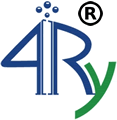About 4Ry
The Science Behind 4Ry’s Spraying
Type of sprayer: Hand-gun sprayer
Pressure: 1.5 bar (atmospheres) or 22 psi
Flow rate: .16 milliliters per second
Voltage: 7 KV
Current: .5 microamps
Power Source: 4 AA batteries
Fluid: Sonneborn PV23 white oil
Understanding Charged Spraying
Understanding spraying—the conversion of bulk liquids to droplets—has been a formidable intellectual challenge. Progress has been slow and with one exception, incomplete. Paradoxically, the exception, charged or electrostatic atomization, is more complex than non-charged spraying but easier to understand. The potential advantages of charged spraying have led to a more “global” or “thermodynamic” perspective that captures the essential features of its overall behavior.
Charged spraying involves nature’s second strongest force (the nuclear force is the strongest): the infinite range electrical force acting on a large population of distinct elements. Every charged spray droplet is intimately interacting at the speed of light with every other droplet. From this perspective, droplet velocity is irrelevant and a droplet’s position is fixed relative to every other droplet. Charged droplet sprays are “well-mixed”: in equilibrium within a maximum entropy system.
Charles Hendricks and his students at the University of Illinois in 1965 obtained charging data for Woods metal and Octoil (a vacuum pump oil) allowing precise values for 𝛼’ (charge conservation) and 𝛽’ (energy conservation) to be established. The values 𝛼’ and 𝛽’ differ by four orders of magnitude between the two test fluids, reflecting their orders of magnitude differences in every physical property. Surprisingly, however, within narrow experimental limits the two fluids have the same 𝛂’/𝜷’ ratio.
Where 4Ry’s Name Comes From
Theory suggests, and the data demonstrate, that charged Woods metal and Octoil sprays self-organize such that each surface charge has ~54 eV of energy. That is, ~54 eV (4 Ry, where Ry, the Rydberg unit, is 13.6 eV) is required to attach an additional surface charge.
While initially observed for only these two Newtonian fluids, the large physical differences between these fluids indicate that most sprays will behave similarly. This has been confirmed by test results with other fluids. The 4 Ry surface charge is the basis of 4Ry’s technology and its name.
The Quantum Mechanics of Charged Spraying
Charged spraying is a quantum mechanical process. Attempts to describe charged spraying without taking the quantum mechanics of surface charge collective behavior into account will fail.
Most importantly, the behavior and characteristics of charged droplet sprays are fully determined by the physics of droplet surface charge and have nothing to do with the engineering details associated with charging the fluid.
A Newtonian liquid when charged will yield predictable, quantitatively definable droplets. Charged non-Newtonian liquids (such as polymer solutions and molten polymers) create nano-fibers. Droplet development and size are independent of flow-rate, fluid properties, and background conditions. The engineering challenge is to impart charge to the fluid.
To do so requires submerging an electron gun in the bulk spray fluid. This takes two forms. The 4Ry Spray Triode Atomizer is a cold cathode emitter situated immediately upstream of an orifice through which the fluid issues—Charge Injected Precision Spraying, or ChIPS. The Spraytron electron gun is appropriate for charging conductive fluids such as water.
Coulomb Repulsion
Upon emission through the Spray Triode Atomizer’s orifice, the behavior of the charged, individual droplets is governed by Coulomb’s law, first published by French physicist Charles-Augustin de Coulomb in 1784.
The law describes the force between electrically charged objects. The electrical force between two charged objects is directly proportional to the product of the charges on the two objects, and inversely proportional to the square of the distance separating the two objects. If the two charges are opposite, one positive and one negative, the force will be attraction. If the charges are the same, either both positive or both negative, the force will be repulsion. The mathematical equation is:
F=ke X ((Q1Q2)/d2)
where F is force in Newtons; ke is Coulomb’s constant (ke=approximately 8.99 x 109N(m2/C2); Q1 represents the quantity of charge on object 1 (in Coulombs); Q2 represents the quantity of charge on object 2 (in Coulombs), and d is the distance of separation between the two objects (in meters).
According to Coulomb’s law, a mass of like-charged droplets will repel each other with the repulsive force quantified by the equation. From a point source like the Spray Triode Atomizer, the overall mass will be propelled in an expanding spray as each droplet separates from every other droplet. The repulsion diminishes as the droplets are distanced from the point source and separate.
The Properties of Charged Droplets
The charge imparted to a droplet will change droplet behavior and characteristics once it leaves the point source. A charged droplet seeks a ground, the target of the spray. Droplets' paths will not be random. Rather, they will be governed by Coulomb-law repulsion and the physics of charged droplets. They will tend to coat the entire target, even those target surfaces and facets inaccessible via a direct, linear path from the point source spray. They will be much less susceptible to random air currents and aerosol drift.
Charging droplets of combustible fluids increase their combustibility. Reducing droplet size also increases combustibility. When such fluids are burned for power, their droplets’ increased combustibility increases efficiency and decreases particulate waste.
Change second to last sentence to: For inquiries about the science behind 4Ry’s spray technology, please contact Dr. Arnold Kelly at [email protected].
For inquiries about 4Ry’s business, please contact CEO Robert Gore at [email protected].
